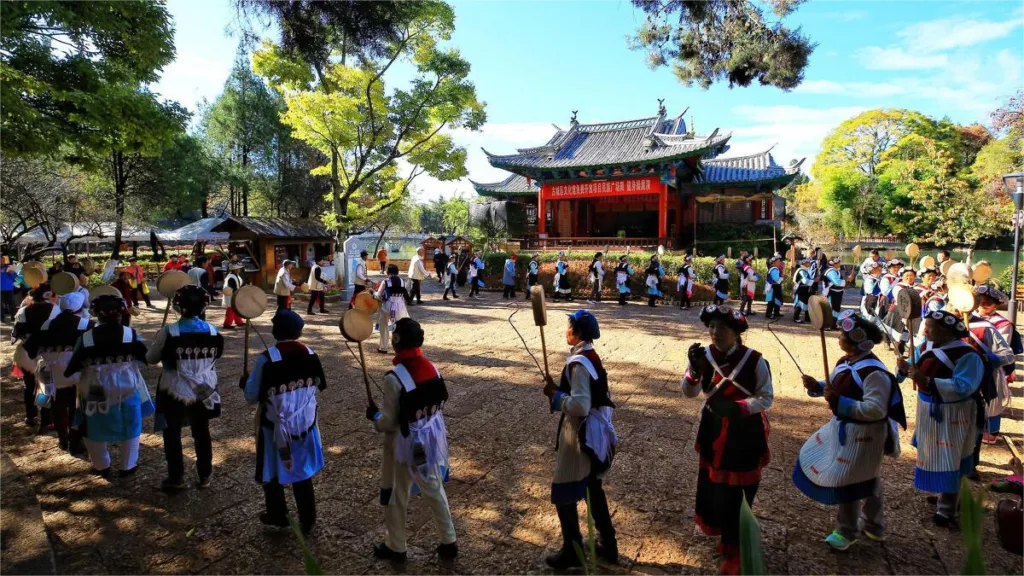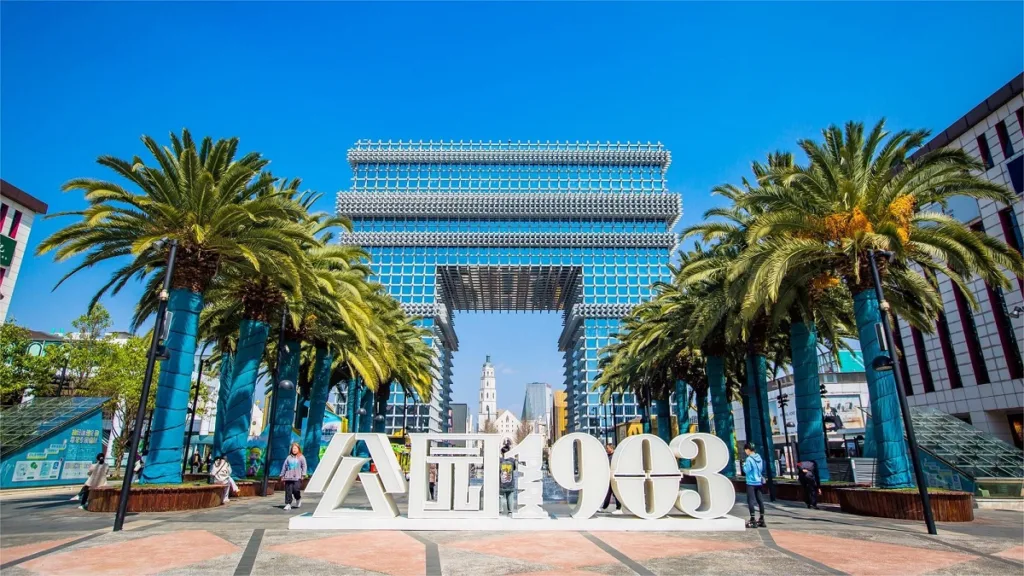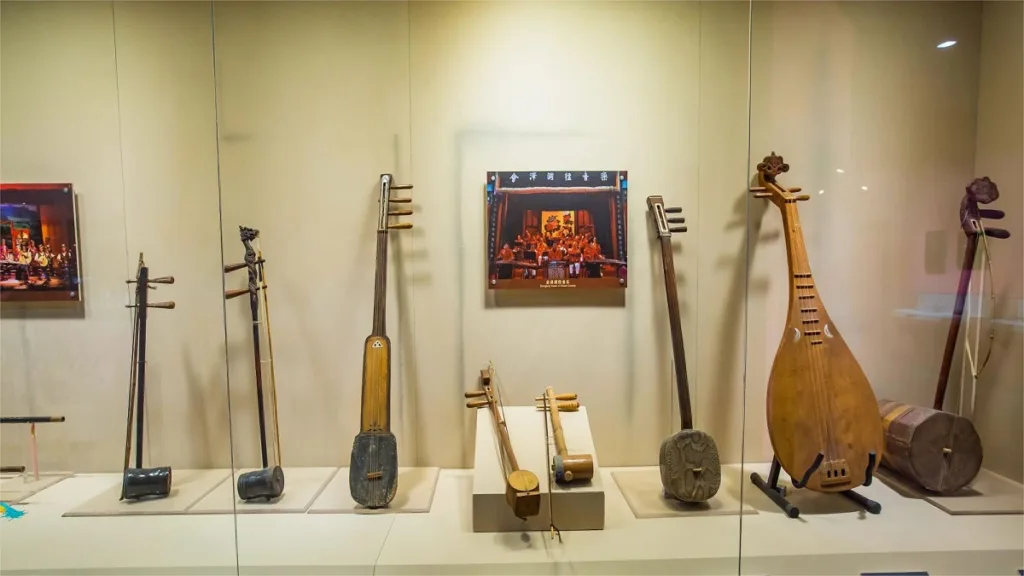Aldea Étnica de Yunnan - Entradas, horarios, ubicación y puntos destacados


Yunnan Ethnic Village (云南民族村) covers an area of 89 hectares and features 256 ethnic villages of Dai, Bai, Yi, and other minority groups, built according to a 1:1 scale. It showcases the architectural art, traditional costumes, cultural customs, religious beliefs, and way of life of various ethnic groups in Yunnan.
During minority festivals such as the Dai “Water Splashing Festival” in April and the Yi “Torch Festival” in July and August, lively celebratory events are held in the ethnic village. Visitors are encouraged to visit during these periods to experience the vibrant ethnic culture firsthand.
While exploring the village, visitors have the option to walk or rent electric cars or tandem bicycles for transportation within the scenic area. There are also facilities such as the Ethnic Unity Square, Ethnic Song and Dance Hall, and a food area offering ethnic delicacies. Visitors can enjoy folk performances, taste ethnic snacks, and purchase ethnic handicrafts. It’s an opportunity to immerse oneself in ethnic culture while enjoying leisurely moments in the village.
Índice
- Información básica
- Ubicación y transporte
- Highlights of Yunnan Ethnic Village
- Dai Ethnic Village
- Water Ethnic Village
- Buyi Ethnic Village
- Bulang Ethnic Village
- Miao Ethnic Village
- Dulong Ethnic Village
- Pumi Ethnic Village
- Nu Ethnic Village
- Lisu Ethnic Village
- Manchu Ethnic Village
- Hui Ethnic Village
- Yao Ethnic Village
- Lahu Ethnic Village
- Wa Ethnic Village
- Kino Ethnic Village
- Mongolian Ethnic Village
- Bai Ethnic Village
- Zhuang Ethnic Village
- Vlog about Yunnan Ethnic Village
- Attractions near Yunnan Ethnic Village
Información básica
| Duración estimada de la visita | 3 horas |
| Precio del billete | Entrada: 90 RMB Admission + The Call of the Plateau Performance: 240 RMB |
| Horario de apertura | Daytime: 9.00 – 18.00; Last admission: 17.00 Nighttime: 17.30 – 21.20; Last admission: 20.00 *All the villages are open during the daytime, while only six villages are open during the nighttime. |
| Número de teléfono | 0086-0871-64311255 0086-0871-68279327 |
Ubicación y transporte
Yunnan Ethnic Village is located on the southwestern outskirts of Kunming, the capital city of Yunnan province, adjacent to Dianchi Lake. The specific address is 1310 Dianchi Road, Xishan District. To get there, you can choose one of the following ways:
Autobús: Take bus 24, 44, 73, 94, 171, A1, or K31 and get off at Yunnan Ethnic Village Stop (云南民族村站).
Metro: The closest metro station to the Yunnan Ethnic Village is Yuhu Village (渔户村) on line 5. After getting out of the station from Exit B, walk about 1.2 kilometers to the south to reach the attraction.
Cable Car: There are cable cars connecting the south gate of Yunnan Ethnic Village with Xishan Forest Park nearby. One-way ticket costs 40 RMB, while a round trip costs 70 RMB.
Highlights of Yunnan Ethnic Village
Dai Ethnic Village
Dai Ethnic Village is the first village you encounter upon entering the Ethnic Village. Covering an area of 27 acres, it is surrounded by water on three sides, with lush greenery providing a serene ambiance. The village is characterized by traditional Dai bamboo houses built in the “ganlan-style,” connected by winding paths made of red sandstone, leading to the solemn Myanmar Temple. The majestic Bai Pagoda, intricate Wind and Rain Bridge, as well as structures like the Wind and Rain Pavilion, water wells, and bell pavilion, exude the rich cultural charm of the Dai people, offering a glimpse into their authentic way of life.
Water Ethnic Village
Water Ethnic Village is built along the water, creating picturesque scenes with agricultural tools as props. It primarily consists of the “street-front house” style of architecture representative of the Guzhang Water Ethnic Township in Fuyuan County, Yunnan. Landmarks such as the Bagua Wheel, Dragon Pond, and Giant Dragon Tree showcase the ancestral customs and unique features of the Water Ethnic culture.
Buyi Ethnic Village
Buyi Ethnic Village, nestled by the water, features two residences that faithfully combine the architectural techniques of the Qiong cage and plank house systems. The waterside pavilions and winding corridors encapsulate both the essence of residential customs and the innovation of garden landscapes, making it a representative example of Buyi culture.
Bulang Ethnic Village
Bulang Ethnic Village is adjacent to Wa Ethnic Village, with structures including residences and a square for rituals and performances. The ritual square embodies the Bulang belief in the spirituality of all things, featuring the Bulang totem in the center. It serves as an essential venue for worshiping spirits, performing dances, and holding traditional folk activities.
Miao Ethnic Village
Miao Ethnic Village is situated in the mountains, showcasing typical “hanging-foot houses” and other dwellings representing the essence of Miao architecture. Visitors can explore the unique culture of the Miao people through displays of traditional attire and handicrafts, as well as experiencing the lifestyle depicted in the residential buildings.Miao Ethnic Village
Dulong Ethnic Village
Dulong Ethnic Village features a typical wooden house representing the plank house system, where a mother and her child once lived, providing a glimpse into their daily life. Additionally, a treehouse structure evokes traces of history, adding depth to the cultural experience.
Pumi Ethnic Village
The Pumi ethnic village predominantly features traditional double-story dwellings constructed with typical wooden framework known as “duo mu”. These houses are arranged in a courtyard style, reflecting the traditional way of life. One of the notable attractions is the Su Li Ma liquor workshop, where visitors can witness the traditional brewing process of Su Li Ma liquor, renowned for its use of barley and earthy flavors.
Nu Ethnic Village
The Nu ethnic village showcases the distinctive architecture of stone-slab roofed houses, with either corridor-style layouts or interconnected tiled rooms. The incorporation of stone steps adds to the dynamic spatial composition, blending seamlessly with the natural surroundings. This village beautifully illustrates the fusion of cultural and natural elements in Nu architecture.
Lisu Ethnic Village
At the Lisu ethnic village, visitors can admire the quintessential “thousand-foot landing” architectural style predominant in Lisu traditional houses. This architectural form highlights the aesthetic preferences and open-minded lifestyle of the Lisu people within the mountainous terrains of Yunnan. The village offers a glimpse into the unique cultural identity of the Lisu community.
Manchu Ethnic Village
Drawing inspiration from both Manchu residences of northeastern Benxi and the traditional quadrangle courtyard architecture of Kunming, the Manchu ethnic village presents a harmonious blend of architectural styles. It serves as a perfect amalgamation of the two distant architectural traditions, showcasing the architectural evolution and cultural exchanges in Yunnan.
Hui Ethnic Village
The Hui ethnic village comprises a cluster of residential buildings, mosques, and streets, adorned with picturesque garden landscapes. It vividly captures the layout and architectural features characteristic of Hui Muslim communities in Yunnan. The village offers a holistic representation of the spatial arrangement and distinctive architectural elements of Hui settlements.
Yao Ethnic Village
In the Yao ethnic village, visitors encounter a charming ensemble of stilted houses, cottages, village temples, granaries, and village gates, carefully arranged in a picturesque manner. The infusion of Taoist cultural elements adds to its authenticity, providing insight into the cultural heritage and beliefs of the Yao people.
Lahu Ethnic Village
Adjacent to the Kino ethnic village, the Lahu ethnic village boasts a variety of traditional structures including thatched cottages, communal houses, churches, and cattle sheds surrounding the iconic gourd-shaped square, symbolizing ancestral reverence. The central gourd square embodies the Lahu’s deep-rooted ancestral worship beliefs, offering a glimpse into their spiritual worldview.
Wa Ethnic Village
Situated at the southeast corner of “Cuiyi Island,” the Wa Ethnic Village is a fascinating blend of traditional thatched-roof stilt buildings, adorned with notable landmarks such as the Bull Head Square, Spirit Square, Stone Carvings of Siganli, and granaries. The Bull Head Square serves as an ancient site for Wa ethnic bullfighting activities, featuring a central bull horn structure symbolizing the village’s foundation. Spirit Square embodies the Wa belief in animism, with stone statues representing revered ancestors.
Kino Ethnic Village
Linked to the Wa and Blang ethnic villages by a bridge and overlooking the water, the Kino Ethnic Village boasts a picturesque landscape adorned with lush greenery and peculiar rock formations. Traditional Kino thatched houses dot the terrain, resembling the undulating hills of Kino Mountain. The village comprises communal houses, residential buildings, granaries, and a central Sun Square, offering insight into the lifestyle of the Kino community.
Mongolian Ethnic Village
Representing the Mongolian community of Tonghai Xingmeng Mongolian Township, the Mongolian Ethnic Village showcases the distinctive “Yike Yin” courtyard-style architecture, Mongolian yurts, and a horse racing field. This combination reflects the nomadic heritage of the Mongolian people while highlighting the unique architectural style prevalent among Yunnan’s Mongolian population.
Bai Ethnic Village
Spanning an area of 62.5 acres, the Bai Ethnic Village is characterized by its exquisite traditional Bai dwellings adorned with flying eaves, dougong brackets, and intricate woodcarvings. The village layout includes features such as the “Three Lanes and One Screen Wall,” “Four Courtyards and Five Skylights,” batik workshops, wood carving workshops, garden tea houses, a theater, and a scaled-down replica of the Dali “Chongsheng Temple Three Pagodas.” The village is traversed by “Dali Street,” lined with craft shops, folk museums, and a butterfly exhibition hall.
Zhuang Ethnic Village
Upon entering the Zhuang Ethnic Village, visitors are greeted by a towering dragon pillar dedicated to the worship of the Dragon King, flanked by cliff paintings depicting ancient deities and a stone gourd pavilion commemorating the legend of aiding ancestors during floods. Prominent structures include the Haotian Pavilion dedicated to the Jade Emperor, a large bronze drum believed to ward off evil spirits, traditional Zhuang residences, a “Love Corridor” for youth socializing, an “Elder Pavilion” for village elders’ meetings, dragon trees, and scenic fields featuring unique bridges and water wheels.
Vlog about Yunnan Ethnic Village
Attractions near Yunnan Ethnic Village

Haigeng Park

Xishan Forest Park

Kunming Park 1903

Yunnan Nationalities Museum
Atracciones de Kunming, Vida local en Yunnan